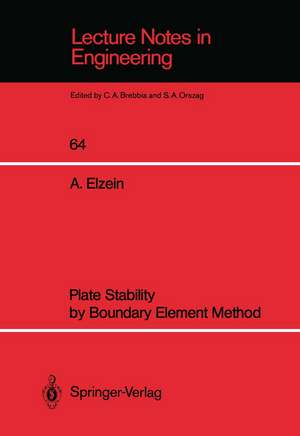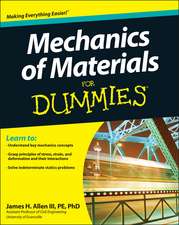Plate Stability by Boundary Element Method: Lecture Notes in Engineering, cartea 64
Autor Abbas Elzeinen Limba Engleză Paperback – 13 mai 1991
Din seria Lecture Notes in Engineering
- 15%
 Preț: 640.37 lei
Preț: 640.37 lei - 15%
 Preț: 643.34 lei
Preț: 643.34 lei - 15%
 Preț: 632.70 lei
Preț: 632.70 lei - 18%
 Preț: 1049.30 lei
Preț: 1049.30 lei - 15%
 Preț: 637.59 lei
Preț: 637.59 lei - 15%
 Preț: 638.89 lei
Preț: 638.89 lei - 15%
 Preț: 637.93 lei
Preț: 637.93 lei - 15%
 Preț: 635.96 lei
Preț: 635.96 lei - 15%
 Preț: 637.78 lei
Preț: 637.78 lei - 18%
 Preț: 957.13 lei
Preț: 957.13 lei -
 Preț: 397.01 lei
Preț: 397.01 lei - 15%
 Preț: 653.79 lei
Preț: 653.79 lei - 15%
 Preț: 638.57 lei
Preț: 638.57 lei - 15%
 Preț: 634.82 lei
Preț: 634.82 lei - 15%
 Preț: 644.18 lei
Preț: 644.18 lei - 15%
 Preț: 635.15 lei
Preț: 635.15 lei - 15%
 Preț: 637.93 lei
Preț: 637.93 lei - 15%
 Preț: 633.19 lei
Preț: 633.19 lei - 15%
 Preț: 653.79 lei
Preț: 653.79 lei - 15%
 Preț: 636.45 lei
Preț: 636.45 lei - 15%
 Preț: 651.02 lei
Preț: 651.02 lei - 20%
 Preț: 645.31 lei
Preț: 645.31 lei - 15%
 Preț: 639.08 lei
Preț: 639.08 lei - 15%
 Preț: 633.19 lei
Preț: 633.19 lei - 15%
 Preț: 655.13 lei
Preț: 655.13 lei - 15%
 Preț: 652.49 lei
Preț: 652.49 lei - 15%
 Preț: 652.81 lei
Preț: 652.81 lei - 15%
 Preț: 643.48 lei
Preț: 643.48 lei - 15%
 Preț: 638.24 lei
Preț: 638.24 lei - 20%
 Preț: 640.51 lei
Preț: 640.51 lei - 15%
 Preț: 675.58 lei
Preț: 675.58 lei - 15%
 Preț: 639.59 lei
Preț: 639.59 lei - 15%
 Preț: 642.18 lei
Preț: 642.18 lei - 15%
 Preț: 638.43 lei
Preț: 638.43 lei -
 Preț: 434.12 lei
Preț: 434.12 lei - 15%
 Preț: 642.68 lei
Preț: 642.68 lei - 15%
 Preț: 647.27 lei
Preț: 647.27 lei - 15%
 Preț: 655.92 lei
Preț: 655.92 lei - 15%
 Preț: 665.73 lei
Preț: 665.73 lei -
 Preț: 411.64 lei
Preț: 411.64 lei -
 Preț: 406.80 lei
Preț: 406.80 lei - 15%
 Preț: 634.68 lei
Preț: 634.68 lei - 15%
 Preț: 650.86 lei
Preț: 650.86 lei - 18%
 Preț: 974.49 lei
Preț: 974.49 lei - 15%
 Preț: 642.68 lei
Preț: 642.68 lei - 15%
 Preț: 635.31 lei
Preț: 635.31 lei - 15%
 Preț: 640.37 lei
Preț: 640.37 lei - 15%
 Preț: 636.45 lei
Preț: 636.45 lei - 20%
 Preț: 659.63 lei
Preț: 659.63 lei - 15%
 Preț: 651.51 lei
Preț: 651.51 lei
Preț: 638.24 lei
Preț vechi: 750.88 lei
-15% Nou
Puncte Express: 957
Preț estimativ în valută:
122.14€ • 132.63$ • 102.60£
122.14€ • 132.63$ • 102.60£
Carte tipărită la comandă
Livrare economică 23 aprilie-07 mai
Preluare comenzi: 021 569.72.76
Specificații
ISBN-13: 9783540537106
ISBN-10: 3540537104
Pagini: 220
Ilustrații: VII, 205 p.
Dimensiuni: 170 x 242 x 12 mm
Greutate: 0.36 kg
Ediția:Softcover reprint of the original 1st ed. 1991
Editura: Springer Berlin, Heidelberg
Colecția Springer
Seria Lecture Notes in Engineering
Locul publicării:Berlin, Heidelberg, Germany
ISBN-10: 3540537104
Pagini: 220
Ilustrații: VII, 205 p.
Dimensiuni: 170 x 242 x 12 mm
Greutate: 0.36 kg
Ediția:Softcover reprint of the original 1st ed. 1991
Editura: Springer Berlin, Heidelberg
Colecția Springer
Seria Lecture Notes in Engineering
Locul publicării:Berlin, Heidelberg, Germany
Public țintă
ResearchCuprins
1 Introduction.- 1.1 Historical Background.- 1.2 Stability.- 1.3 Experimental and Numerical Modelling.- 1.4 The Boundary Element Method.- 1.5 Plate Stability by BEM.- 1.6 Scope of the Present Work.- 2 Plate Stability Theory.- 2.1 Introduction.- 2.2 Stability of Structural Systems.- 2.3 Linear Theory.- 2.4 Large Deflections.- 2.5 Boundary Conditions.- 2.6 Numerical and Experimental Studies.- 2.7 Conclusions.- 3 Membrane State of Stress.- 3.1 Introduction.- 3.2 Boundary Integral Formulation.- 3.3 Boundary Element Solution.- 3.4 Numerical Implementation.- 3.5 Results.- 3.6 Conclusions.- 4 Critical Loads.- 4.1 Introduction.- 4.2 Boundary Integral Formulation.- 4.3 Boundary Element Solution.- 4.4 Numerical Implementation.- 4.5 Results.- 4.6 Conclusions.- 5 Dual Reciprocity.- 5.1 Introduction.- 5.2 Outline of the Method.- 5.3 The Discrete Points Fourier Analysis.- 5.4 The Deflection Models.- 5.5 Transformation of L(w).- 5.6 Transformation of the Domain Integral.- 5.7 The Problem of Singular Integrals.- 5.8 Eigenvalue Problem.- 5.9 Numerical Implementation.- 5.10 Results.- 5.11 Conclusions.- 6 Large Deflections.- 6.1 Introduction.- 6.2 Boundary Integral Formulation.- 6.3 Domain Deflection Models.- 6.4 Boundary Element Solution.- 6.5 Solution of the System of Equations.- 6.6 Numerical Implementation.- 6.7 Results.- 6.8 Conclusions.- 7 Conclusions.- Appendix A The Green’s Identities.- Appendix B Functions of the Fundamental Solutions.- Appendix C Trigonometric Deflection Functions.- References.







